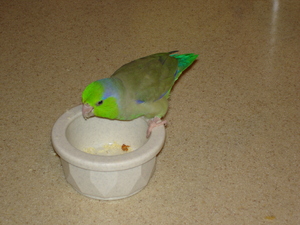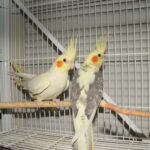Parrotlets are the little clowns of the parrot world. The smaller relatives of the Amazon parrots, parrotlets are pocket-sized for convenience and only reach an adult weight of roughly an ounce. I have been the proud owner of a parrotlet myself for four years, and they are charming little creatures.
Parrotlets have only begun to be domesticated within the last fifty years, hence the reason few people know about this well-kept secret of the avian world. These tiny parrots make up for their lack of size with their personality and their coloration. My lucido pacific blue parrotlet, is of the more common color scheme, with an olive green back, a royal blue rump, lime-green head, and turquoise eye streaks. Other varieties of parrotlets may be yellow with purple eye streaks, or aquamarine colored with blue eye streaks. Another helpful fact is that parrotlets’ sex can be determined as soon as their feathers come in-only the males have the “eye shadow”, that is, the eye streaks. Not only does this make breeding easier, but it also makes life easier when you have other birds of one sex.
In terms of their personality, parrotlets are outgoing, active, playful, and talkative. While most small birds such as finches and parakeets tend to be constantly fidgeting, flapping, or screaming, and better for viewing rather than handling purposes, parrotlets have a balanced personality. Once they become accustomed to your presence, they will let you hold them, and, if they trust you enough, they’ll even let you turn them on their back and stroke their bellies. Parrotlets are perfectly content to sit in their owners’ hair or on their shoulder, and while they enjoy playful days they relish in “quiet time” too. Furthermore, parrotlets are generally very tolerant of large groups of people. Unlike cockatiels or cockatoos, which pair-bond to one person only, parrotlets have a favorite, but they are sociable and loving with everyone.
Do not be discouraged by the size of parrotlet-though tiny, their intellectual capacity is astounding and among the highest of all birds. And with parrotlets, you don’t have to fear your young child losing his finger to a macaw’s large beak; parrotlets rarely bite unless provoked, and mostly engage in “tasting”, lightly “nibbling” on a person’s finger to identify the taste as the person they think it is. Parrotlets love to sing, and love to be talked to. Above all else, what parrotlets need is a stimulating environment. They need owners to interact with them, and it is astounding how much they learn. My parrotlet, Kiwi, gives me kisses all the time, and can say “take a bath”, “give us a kiss”, “kiwi is a pretty pretty bird”, “step up”, “come here”, “go school”, “go sleepy”, and many other phrases that he’s picked up fairly quickly. Contrary to popular belief, parrotlets do not only repeat human speech, but they have the capacity to understand it and use it in context as well. For instance, if Kiwi wants out of his cage, we’ve trained him to use “come here”, and if he wants to be held, he says “step up”. Parrotlets are highly intelligent and easily trained; repetition generally does the trick, along with clear, high-pitched speech.
Thus far it is recorded that the lifespan of the parrotlet ranges from 20-30 years. Indeed, they are a commitment, but if given the proper care and attention, they will return your love tenfold and serve as a wonderful and personable companion in any household.



